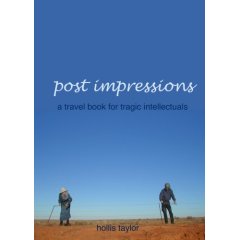
Jon Rose's fence project, now more than a decade underway, has proven to be one of the richest sources of inspiration in a long career of not just playing but re-conceptualizing the violin. Starting with his 1997 album The Fence, which had him bowing on fences on contested national borders (augmented with news reports from the regions), the fence work has been a new angle for him, founded more in being resourceful than fanciful.
The project has also brought him together with one of the most kindred collaborators: fellow violinist Hollis Taylor, an American apparently willing to accompany him on his doggedly determined treks. The pair released the unexpectedly beautiful Great Fences of Australia in 2002, and now follow it up with a further exploration of the sound properties of fences in the book and DVD set Post Impressions.
The concept is as simple as the sound is surprising: put a microphone up to a fencepost, then bow and rattle its wires. In Australia, where government fences are erected to control the population of scavenging dingoes, that can mean an instrument stretching more than 3,000 miles (or, as Taylor notes, twice the length of the Great Wall of China). Her book (which includes occasional comments from Rose and transcribed interviews from the Outback) amounts to a travel guide for a trip no one in their right mind would make. The journey is a lonely one - much of Australia is barren desert, and their path is lined with insect infestations and kangaroo corpses - and Taylor is a lively enough writer to make the journey come alive on paper:
Like some wildlife, artists are edge-dwellers. They work on the fringe, the brink, and beyond, refusing to take boundaries at their fixed and unbreachable word, extravagantly wandering off paths and overstepping orderly lines. But stretching, crossing, or breaking barriers is one thing as metaphor and quite another when you're poking about the land, physically experiencing the fence as stranger, outsider, and potential troublemaker. A fence serves as a moral boundary post; forgive us our trespasses. When people approach us, we have mere seconds to decide whether to puff up or apologize.
It's a good read, full of easily digested meditations on music making, sounds of the natural world, and the psychological implications of territorial thought. But it's the promise of the DVD that will be the inroad for most. And where Great Fences of Australia was a mesmerizing, mystifying piece of audio artistry, the DVD strips that down to its component parts: short tracks (40 of them in just under two hours) generally showing two or three audio possibilities per locale. Despite being made with a single handheld camera while touring in a campervan, the footage is diverse, interesting and well edited. But it feels supplemental to Great Fences. In a previous Squid's Ear review, I called that record a Discovery Channel story. I was wrong. This is the documentary package, Great Fences is the fruit of their toils.
243 pgs, with DVD
Comments and Feedback:
|



